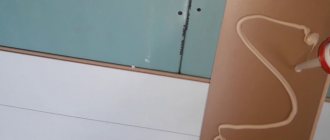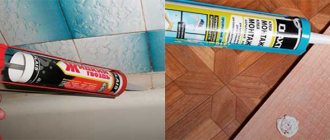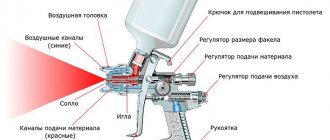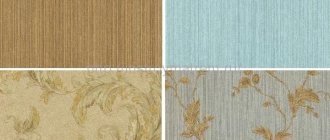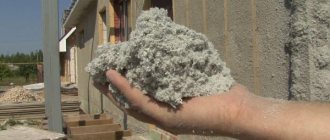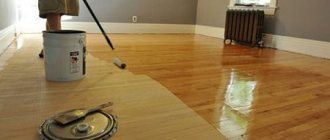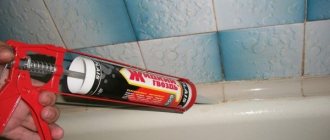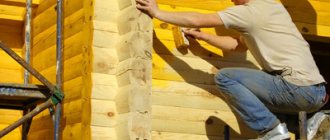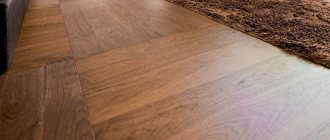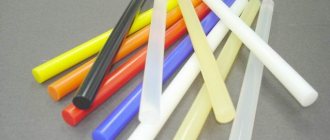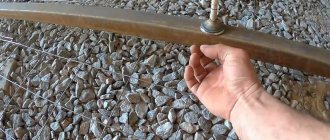For adhesion of complex surfaces during repairs and fastening of heavy decorative elements, liquid nails (LN) are widely used. This is a special adhesive component that has high adhesion and a structure that can penetrate hard-to-reach places. This explains the popularity of the editing team. How to use liquid nails, what features of application there are, we will consider below.
Instructions with a gun, why it is convenient
A glue gun makes working with glue in tubes much easier.
In short, without this device it is impossible to achieve maximum accuracy and evenness in applying the composition. The consumption of liquid nails will be higher, and the strength of the seam will be lower. A tool such as a gun is not cheap, and many people try to do without it, especially if there are minor jobs to be done. Mechanical models cost around a thousand rubles, professional ones are more expensive. Perhaps you should still think about buying this unit, especially if you have to install or repair something large and durable.
The design of the glue gun is simple and straightforward:
- The glue tube is placed in the gun.
- By moving the trigger, the structure is activated: the lever is connected to a disk that will press on the tube.
- The glue comes out of the tip under pressure.
There are different models of pistols for different purposes:
- Mechanical - works by pressing the lever on your own.
- Pneumatic - pressing due to air flow (set by lowering the handle).
- Rechargeable - runs on batteries / accumulator, the process is automated.
- Electric - connects to the network.
The gun allows you to achieve continuous pressure on the glue tube. The seams are very smooth, neat, uniform
This is very important in installation work
How to use liquid nails with a gun, instructions:
- Retract the gun rod as far as it will go by pressing the locking lever.
- Insert the tube of glue and secure with the lever.
- Remove the cone and cut the cap at a slight angle using a sharp knife. The farther from the tip you cut, the wider the layer of glue that comes out, and vice versa. The cone cutting angle recommended by builders is 45 degrees.
- Press the lever several times until the glue flows into the dispenser.
- Press and hold the lever so that the glue is distributed evenly over the prepared surface.
- To distribute the glue pointwise, briefly press the tube while moving the dispenser over the surface.
- When finished, remove all traces of glue from the gun and wipe it with a rag soaked in water or solvent. Clean power tools after unplugging them.
- Do not forget to first clean the surfaces to be glued from dust, dirt and grease. Working with wet materials is not allowed unless there are serious reasons for doing so. Carry out work outdoors only at above-zero temperatures, using rubber-based compounds. Leave water-soluble mixtures for interior work.
That's all the tips for working with liquid nails. Choose the optimal gluing method based on the instructions for the composition and the properties of the selected surfaces. Having experience in installation work, you can easily do without a special gun, but those who are doing repairs for the first time should think about purchasing or renting a device. Good luck with your installation work!
How to calculate quantity
Usually the average consumption of the composition per square meter is indicated on the packaging. But it is worth considering that other factors also influence consumption:
- Irregularities. Various defects require the application of more LG;
- Density of composition. It also depends on the ambient temperature. The warmer it is, the faster the moisture evaporates, after which the glue becomes thicker. And a thick composition is consumed more;
- Tool and qualifications of the worker. Different instruments can “consume” liquid gas in different ways. For example, this depends on the shape and size of the spatula teeth. And of course, a master, as a rule, uses the optimal amount of glue, unlike an amateur.
General instructions: how to use liquid nails correctly
Liquid wallpaper.
types, how to make, how to apply, etc. Liquid nails “Titebond” of different types have general rules for use.
- Surfaces are pre-treated: cleaned and degreased.
- Using a construction gun, glue is applied using one of the methods (snake, dots, mesh).
- The fastened elements are pressed tightly against each other and held for 5 minutes.
- Wait for complete drying (about a day), then mechanically act on the surface, if necessary.
Not everyone knows how to install a bottle of liquid nails in a construction gun. The following video will help you understand the procedure and basic operating principles.
Removing glue from the surface cannot be ignored. High adhesive strength complicates the procedure. The following options are possible:
- Newly applied adhesive is easy to remove. You will need a sponge, water or solvent (mineral base);
- Dried nails are removed with a special cleaner or scraper;
- Heating. The critical temperature for the material is + 50 °C; when heated above this value, the glue will become viscous and can be removed without much effort;
- Liquid nails are removed after prolonged exposure of the bonded surface to direct sunlight.
Area of use and differences between types
Liquid nails are popular in construction and renovation. Purchase them for any task. The cost is low, equal to half the cost of polyurethane foam.
A common example of using liquid nails is fastening materials to brick structures, gluing wooden surfaces, fixing fiberboard and chipboard sheets. Nails are also used for gluing ceramics, polystyrene, glass or even metal; with their help it is easy to glue foam.
A useful function due to which liquid nails are valued by professional builders is gluing surfaces that do not fit tightly together. When using liquid nails, to fix such surfaces you will need to squeeze out a little more from the tube.
Restrictions on the use of liquid nails - they are not used for gluing damp or damp wood; they cannot be used to glue an aquarium, not even because of constant contact with water, but because of the slow decomposition and subsequent poisoning of the inhabitants. Silicone sealant is suitable for these purposes.
Liquid nails are used in small decorations, when you need to efficiently but discreetly fix an element on a wall or ceiling, glue a torn part, etc.
Liquid nails are purchased from different manufacturers and in different volumes, which also affects the price.
If you perform a small amount of work, then a minimum amount of liquid nails is enough; for a large front, purchase a large tube. The larger the volume, the lower the total cost.
How to use liquid nails without a gun
How to work with polyurethane foam without a gun? valuable recommendations from professionals
- Luda, look, am I like the Terminator? - Yeah. only liquid.
(excerpt from Comedy Club).
I am glad to welcome the honorable reader!
Liquid nails are a type of construction and installation adhesive used for fastening various materials. It is based on polymers and synthetic rubbers, the proportions and quality of which determine adhesion (degree of adhesion).
FYI: The name comes from the name of the product, Liqu >
The specifics of the product require certain understanding and skills. Otherwise, there is a risk of damaging the bonded surface. In this regard, our topic of this article is liquid nails instructions for use. In addition, it will be useful to know how and with what to clean the surface if something goes wrong. Go!
From this article you will learn:
How to use? Instructions for use
Please read the instructions first! Remember that LGs have a limited shelf life. Be sure to check the manufacturing date before purchasing. If liquid nails are water-based, they must be glued at an air temperature of at least +5°C. If it’s organic, take care to constantly ventilate the room. Whenever possible, perform work outdoors.
Nuances of choice
Construction stores often have many brands, but give preference to the one that has the best “specialty” for the work you are going to do.
- For ceramics, acrylic gels are good. There are brands with increased resistance to humidity (which can be used in bathrooms) and low vibrations;
- It is better to glue baseboards, moldings, etc. with quickly hardening compounds;
- For heavy elements, choose high-strength LG;
For example, the well-known “Moment” has ten varieties, allowing you to more accurately select the desired option. Including: for polystyrene, wood, mirrors, concrete, cork, stone. There are especially strong (usually more expensive) compositions designed for the installation of heavy structures.
Sequence of gluing parts
How to apply liquid wallpaper with your own hands: 110 photo examples and a video lesson on how to apply liquid wallpaper correctly
To release the glue from the tube, you need to press the gun handle with frequent hand movements.
The threaded head of the tube is cut off with a sharp knife or the membrane is pierced with a sharp object. A conical tip is screwed onto the head and the cap is removed from it. The edge of the tip is cut at an angle of 45°, and the cap is put on again. The glue cartridge is ready for use.
Before inserting the cartridge into the gun, the operating rod must be relaxed. The tube is inserted into the device; by pressing the trigger, the rod is clamped until it stops. The cap is removed. By frequently pressing the handle, the glue is applied to the surface in an even strip or dotted fragments. To glue large surfaces, a mesh or snake is applied.
The surfaces to be glued are pressed and, if necessary, fixed with additional devices. Individual flat parts can be pressed down with a press. Some types of glue set within 1-2 minutes.
The total bonding time of the parts is usually 12-24 hours.
The area of surfaces prepared for gluing should be taken into account. Do not completely cover large surfaces to be glued with glue and do not apply excess glue. This will increase the setting time of the composition. To glue decorative parts, the cut is made with the smallest distance from the end of the cone.
Excess glue that appears is wiped off with a rag soaked in solvent. Glue stains remaining on wood parts can be washed off with a special cleaner. The glued structure can be used no earlier than after 24 hours.
Rules for working with adhesive
The durability and strength of the connection entirely depend on following the rules and following the instructions, which are detailed on the packaging.
To glue two materials together, proceed as follows:
- Thoroughly clean the parts from dust and dirt, scrape off any remaining paint, and treat with alcohol or acetone. It is recommended to make notches on smooth material to make the surface rough.
- The glue is applied using a special gun in dots, stripes and zigzags. Do not cover the entire area. Using the gun is very easy: a can of glue is inserted into a niche specially designed for this purpose, and by pressing the trigger, the adhesive is supplied in portions to the intended location.
- The surfaces to be glued are tightly attracted to each other and kept in this position for at least two minutes. Within a few minutes it will still be possible to correct the part, and the glue will finally harden no earlier than in a day.
Sometimes the manufacturer advises doing the following: apply glue, attach the surfaces to each other, then separate them and wait 10-15 minutes until the adhesive sets a little, and only then finally connect the parts.
Applying glue with a gun: tips and tricks
Before squeezing the substance onto the materials to be glued, it is recommended to understand how to do this correctly. If you plan to glue large and heavy parts, such as ceramic tiles or gypsum structures, then it is better to apply the glue continuously in the form of a snake or mesh. This will increase the gluing area and also ensure the reliability of the connection.
The setting speed of liquid nails is from 1 to 2 minutes, which depends on the materials being glued. After applying the substance, you need to press them tightly together and hold for at least 1 minute, and preferably 2 minutes, which will be more reliable. If possible, a press can be used, especially when joining wooden structures.
This is interesting!
The more substance is applied to the connecting materials, the longer it takes for them to harden.
How to use glue (instructions for use)
Before you start gluing any surfaces with liquid nails, you need to carefully study the instructions for use of the tool and glue itself. LG has a limited shelf life - check the date on the packaging. Water-based compounds cannot be used at temperatures below +5 degrees. It is advisable to ventilate the room during work.
Classic rules
Modern adhesive compositions have good adhesive properties, but for a strong connection of the glue with the base, you must adhere to the following recommendations and follow the instructions for using the liquid nail gun:
- Remove dirt, dust, and construction debris from the surface.
- Degrease the parts to be glued with an alcohol solution.
- Pre-treat porous material with a primer.
- Puncture the tube with glue and insert it into the gun, fix it.
- Apply the adhesive composition pointwise, in a snake, in a stack, or in strips.
- Connect the glued fragments tightly and press firmly.
- Remove excess liquid nails and leave the parts to dry.
Until the composition has completely hardened (approximately a day), mechanical impact cannot be exerted on the connected surfaces. If you need to glue flat fragments with a liquid nail gun, I use a press to fit the parts more tightly.
Use with gun
According to the principle of operation, the ZhG instrument resembles a syringe. The work process is briefly as follows: insert the tube of glue into the gun, securely install the container, and squeeze out the required amount of liquid nails. To insert a new cartridge, the rod is moved back all the way and the spare tube is “recharged”.
To open a sealed container, you need to pay attention to the type of blockage. If the container is plastic, simply cut off the sealed protrusion with a sharp knife and remove the blockage
Iron tubes are pierced with an awl or a nail. The method of applying glue is chosen depending on the type of surface: on tiles - dotted, on baseboards - in stripes, on large products - in a mesh or snake. The principle of “more glue - stronger adhesion” does not work in the case of liquid nails. Excessive amounts of the composition only increases the drying speed of the product.
Just recently, a new building material appeared on the market - “liquid nails” glue. Compared to its analogues, the quality and efficiency of working with it has increased significantly. For use at home, it is provided in a certain volume - from 250 to 1000 ml. Compared to PVA glue, this building material glues the parts and materials you need much better and stronger.
Glue composition: how to choose the right material for the job
In order to get the job done faster and better, you need to choose the right glue. They come in two types:
- with plastic clay in the composition - a more expensive and high-quality option;
- with chalk in the composition - a budget option.
The second option has worse adhesion to materials compared to the first
Another factor that you should pay attention to is the composition of the polymers. Some of them can corrode materials, and some may not glue what is needed at all.
Thanks to bit brand liquid nail adhesive, you can glue a variety of materials. Such as:
- Fiberboard and chipboard;
- various metal parts;
- ceramic tiles;
- bamboo wallpaper;
- glass;
- plastic.
Preparing surfaces for gluing
Before gluing, you need to carefully prepare the work surface. First you need to clean it well - remove any remaining dirt and dust, dry it completely and degrease it. To work with glue, you need to use a special mechanical gun, which, when pressed, squeezes out the required amount of material.
Then a universal tube is inserted into the gun, the working rod is pressed all the way to its lower part.
Glue, for more accurate gluing, should be applied to both surfaces. If the gluing area is small, then a few dots will suffice, but if the area is large, then you need to apply glue in the shape of a snake or mesh. After which, you need to wait 12-24 hours (depending on what material you are dealing with).
The drying time depends on the temperature and humidity in the room. The ideal option would be to wait a day after gluing to ensure a good result.
You can use bit brand glue when working with completely different materials and parts. The main thing is to use the glue for its intended purpose. If you don’t have a mechanical gun, you can use improvised means. With proper storage and use of glue, liquid nails, service life and quality of work increase.
Product Features and Applications
Liquid nails are a construction and installation adhesive based on polymers and synthetic rubbers, which allows you to fasten materials of different structures, providing a high degree of adhesion (adhesion) of surfaces. The product is produced under several brands. The composition and properties of specific products may vary. In any case, manufacturers claim that the glue can withstand loads of up to 90 kg/cm². The product is sold in cartridge tubes with a volume of 0.3 liters or more.
The basic composition of liquid nails includes synthetic rubber, polymers and fine filler. It is the presence of the last component that distinguishes this glue from the rest. It allows you to firmly connect surfaces that do not fit tightly.
In the classic version of Liquid Nails, Texas clay, which has increased plasticity, is used as a fine-grained filler. Many manufacturers replace it with chalk (calcium carbonate), but its adhesive properties are worse.
An important point that you should pay attention to when choosing glue is the absence of toluene and acetone in the composition. The first component improves the adhesion characteristics of the product, and the second accelerates drying
But they are toxins for humans. A sign of their presence is a sharp, suffocating smell.
The main areas of use of liquid nails are fixation of various materials:
- ceramic tiles;
- cork panels;
- plastic;
- drywall;
- wood;
- aluminum, teflon;
- glass, mirrors;
- ceramics;
- chipboard, OSB, fiberboard;
- polyethylene;
- polystyrene foam;
- concrete, gas and foam blocks, bricks;
- heavy wallpaper on a natural basis and so on.
In addition, the adhesive can be used to seal seams and cracks in bathrooms, window and door openings, walls, furniture and so on. But its effectiveness compared to special sealants is questionable.
Considering the relatively high cost of liquid nails, it is not advisable to use them for connecting large structures. For example, you should not use it to tile the entire bathroom. But gluing individual parts is quite reasonable.
Universal liquid nails
Universal type liquid nails will be excellent helpers for repairs and problems in everyday life. With the help of one tube you can solve several everyday issues at once that you never had time for. Repair experts recommend the following options.
BISON Expert KM-100
The composition from a domestic manufacturer has a long service life and has a powerful adhesive function. ZUBR Expert glue is not only capable of firmly connecting parts, but also filling existing voids, which significantly increases the service life of the connection. This gluing option is resistant to humidity and temperature changes, withstands frost and direct sunlight, and is also resistant to any accidental mechanical damage. It is recommended to apply this glue at temperatures no higher than +30 degrees. And the temperature during operation can be from -30 to +80 degrees Celsius. This type of liquid nails can be used for wood, metal, plastic, chipboard, fiberboard, porcelain, ceramics and other materials. The composition of a light beige shade behaves well even in professional installation work. The cost of a 300 ml bottle is about 200 rubles.
BISON Expert KM-100
pros
- long service life;
- good connection quality;
- suitable for various materials;
- resistant to temperature changes.
Minuses
The beige shade does not look attractive in any work.
Liquid nails BISON Expert KM-100
Titebond Multi Purpose
American liquid nails differ from other glue options by being especially durable. Titebond Multi Purpose adhesive is suitable for both internal and external finishing and repair work, and can also be used to connect surfaces made of various materials - metal, tiles, concrete, wood, MDF, chipboard and others. Liquid nails glue the necessary surfaces in just 20-30 minutes, creating a super-strong connection that is resistant to moisture, mechanical damage and temperature changes. The glue has a milky beige color and does not have a strong odor. The cost of a 300 ml bottle is about 250 rubles.
Titebond Multi Purpose
pros
- super strong connection;
- non-toxic and does not cause allergic reactions;
- suitable for various materials;
- frost-resistant;
- resistant to moisture;
- dries completely in just 30 minutes.
Minuses
a light beige shade is not visually suitable for all finishing work.
Titebond Multi Purpose Liquid Nails
Torque Installation Universal
Liquid nails from the most famous domestic manufacturer have a pleasant ratio of decent quality and low price. A universal type adhesive does an excellent job of gluing various materials - wood, concrete, tiles, brick, chipboard, metal, fiberglass, polystyrene foam, etc. The glue sets in just 15-30 minutes, depending on the material. And after complete drying, the compound can withstand a load of up to 40 kilograms per square meter. meter. The glue is resistant to temperature changes from -30 to +60 degrees. The average cost of a 400 ml bottle of glue will be only 230 rubles.
Torque Installation Universal
pros
- cost/quality ratio;
- economical consumption;
- high connection strength;
- the connection can withstand heavy loads;
- sets quickly;
- resistant to moisture;
- frost-resistant;
- elastic;
- convenient packaging with a spout;
- versatility of use;
- Suitable even for uneven surfaces.
Minuses
- toxic;
- has a pungent odor.
Liquid nails Moment Installation Universal
How to clean the surface
The procedure for removing excess or residues of liquid gas has several solutions and depends on the time of application and the material on the surface of which it is applied. Let's list the main ones:
- Fresh residues can be removed with a sponge and warm water (or mineral solvent);
- Dried adhesive can be removed with a special cleaner. It is sold in hardware stores;
- If cleaner is not available, a scraper or blade can be used, although this is not suitable for all surfaces;
- Another option for dried glue is increasing the temperature. Since liquid gas generators are operated at a temperature (as a rule) of no more than 50°C, then when heated to 55-65°C, the composition goes into a semi-liquid state and is removed with a scraper;
- An exotic option for old glue is exposure to direct sunlight. Again, we use the “weak points” indicated in the instructions. Staying under the rays softens the liquid gas, subsequently mechanical cleansing with washing is carried out (see the first option).
In general, liquid nails are an effective “lifesaver” for small household repairs. The photo above shows my personal choice. This glue from the company Macroflex has proven itself amazingly in many repair work, especially since it has a very affordable price. Don't take this as an advertisement, take my word for it, I know what I'm saying. I will end here. I hope it was informative... Subscribe to the blog, introduce friends and comment on articles. Hearing an outsider's opinion is always useful...
An anecdote on the topic: Few people know that in the Moment glue production workshop there is always a rosy and positive atmosphere.
Good luck to you in your family affairs and, of course, in construction! Bye!
Wisdom Quote: If all men thought alike, no one would gamble at the races (Mark Twain).
https://youtube.com/watch?v=3GI61aTm67Y
If the sealant is packaged in a suitable container
A number of manufacturers complete the container with a disposable “syringe”. There is only one drawback - sealant that has not been used for its intended purpose cannot be used subsequently. Therefore, it is worth taking a closer look at the shape of the container - if it has protrusions into which you can insert your fingers, then such a sealant is not easy, but it is possible to squeeze out without any devices.
Other methods involve disassembling the container. To do this you need:
- Carefully remove the spout from the bottle. Direct the container itself in the opposite direction (there should be no people there).
- Cut off the end of the tube using a sharp knife.
- Place the spout in its original place, having first removed the cap from it.
- Insert the handle of a regular plumbing hammer into the bottom of the tube. The T-shaped profile of such an “extruder” will create a fairly uniform pressure.
To ensure uniformity of the extruded layer of sealant, it is advisable to keep the pressing force constant. The width of the hammer should be 5...10 mm less than the inner diameter of the tube. If you don’t have such a hammer at hand, you need to use a similar object with a suitable cross-section. The heavier it is, the easier it is to squeeze out the sealant.
Types of sealants for construction work
The first and one of the most popular types is acrylic material. It consists of special acrylic resins. At the moment of completion of hardening, it acquires low elasticity. It also has increased adhesive properties with building materials that have high porosity. Therefore, it is most often used to work with the following materials:
- with concrete;
- with brick;
- with solid wood.
Also among the distinctive features is the ability to be used only for interior work. This is due to the fact that acrylic sealant is not able to withstand sub-zero temperatures. The maximum value at which the sealant feels good is at -20 degrees.
Due to some differences in characteristics, acrylic sealant is used to quickly seal doorways and window frames. They can also be painted with acrylic paints. There are waterproof and non-waterproof. The latter are completely environmentally safe. But they are not suitable for finishing a bathroom.
In addition to acrylic, the following types of sealant are used:
silicone-based composition;
The main component, as the name suggests, is 45% silicone. They are distinguished by high elasticity even at the moment of hardening. Interacts well with almost all materials, including ceramics, glass, aluminum.
Among the technical properties, it is worth noting enhanced resistance to water. Therefore, it is actively used for arranging bathrooms and other objects with high levels of humidity. Silicone compounds have their own subtypes:
- general purpose materials – structure of over 45% silicone rubber and 45% hydrophobic filler;
- sanitary silicone sealant - the composition of this material includes additional antifungal additives. Due to the latter, the material is protected from mold. It is this type that is most widely used for arranging structures with high humidity;
- special sealant for water containers - aquariums.
Sealant for treating window frames - has additives that increase resistance to UV radiation. This type is resistant to the formation of fungus and mold.
compositions based on polyurethane;
Such materials are characterized by increased strength and enhanced elastic properties. Due to this, the compositions are widely used in external construction work.
But there is one important drawback - high toxicity before polymerization. This disadvantage makes them extremely unsafe for interior work. Therefore, they must be used for external processing.
Note: When working with polyurethane sealant, you must use personal protective equipment.
bituminous compounds and sealants for processing threaded connections;
The former are widely used in external construction work for roofing. They are characterized by increased adhesive properties, resistance to moisture and other external influences. They need to be applied only at positive temperatures, but after drying they interact well with negative temperatures down to -50 degrees.
Sealants used for processing threaded connections are highly targeted. It is used only for working with threaded connections.
There are also combined types of material. But they are distinguished by their high cost, due to which they are not in wide demand.
How to use liquid nails without a gun
It often happens that you need to fix a plinth or wall apron in place, but you don’t have a construction gun at hand. Then you have to use improvised means and your own ingenuity. If the material is packaged in a hard tube, then proceed as follows:
- Find a flat, round object with a diameter suitable for the bottom of the cartridge. For example, you can take a bottle cap that will act as a piston.
- Place the dispenser on the neck of the tube, open it or cut off the tip.
- Place a homemade piston against the bottom of the cartridge and, using a handle, create pressure on the glue, gradually releasing it onto the surfaces to be glued.
Work very carefully so as not to damage the glue container. At the same time, try to distribute the liquid nails evenly in a homogeneous layer.
If you use paste in a soft container, it can be squeezed out through a small hole. However, such a process is quite difficult to control in terms of uniform application, so the connection may not be very strong and reliable.
Why are they needed?
The range of bonded surfaces is quite wide: for plastic, ceramic tiles, gypsum panels, metal, chipboard, fiberboard, OSB, foam and gas block, bricks, polyethylene, glass, Teflon, concrete and others. Allows you to connect even loosely adjacent surfaces. Some types of LG (liquid nails) can withstand loads of up to 90 kg / cm²!
Considering the relatively high cost of LG, it is irrational to replace them with simpler and less expensive adhesive compositions, but for minor repairs (tiles have fallen off, wallpaper or baseboards have come off, etc.) - it’s always just right.
Device design
Related article: Grout gun: types and tips for use
Before using a liquid nail gun, it won’t hurt to understand the device’s structure. This will help to properly securely fix the glue bottle and apply the product evenly. The design of the device consists of the following parts:
- Metal body.
- Platform for the cylinder.
- The handle is the trigger.
- Tube landing lever.
- Push rod.
- Locking tongue.
- Disc piston on rod.
To use a liquid nail gun, attach a tube of glue to the body of the tool. When you press the lever (trigger), the disk presses on the base of the cylinder and pushes the glue out of it, the composition is supplied in doses. To minimize the excess consumption of liquid substance at the beginning of the work process, a hermetically sealed tube must be fixed to the gun.
What you need for work
The process of connecting different surfaces is carried out provided that all the necessary tools and materials have been prepared. So, to work you will need:
- tube with adhesive material;
- sharpened knife;
- protective equipment: gloves, glasses;
- if you plan to use liquid nails based on an organic solvent, prepare a respirator;
- a solvent that can be used to clean surfaces and workplaces from excess glue;
- rag/sponge.
Device operation
An additional advantage of using guns is the simple operating principle of the tool. After placing the sealed cylinder on the platform and securely fixing it, you need to pull the trigger. It activates the rod-rod, which, in turn, moves the disk piston, which acts on the base of the cylinder. Under pressure, the glue flows out of the tip of the tube. How to use a liquid nail gun:
- You need to put a sealed package with glue on the tip.
- Before use, you must ensure that it is securely attached.
- To reduce the pressure in the tube, the trigger is pulled back slightly.
- If the bottle is not installed correctly, the liquid nails will dry out.
- Before installing the nozzle, you need to check that there is no restrictive bottom on the tube.
To open liquid nails for a skeleton or semi-open gun, you need to remove the lock from the base of the cylinder, remove the stem (retract it) and secure the tube. You need to press the lever with some force two or three times to finally fix the cylinder. You need to pierce a hole in the container through which liquid nails will flow to the tip. A tubular gun, which works on the principle of a syringe, is filled in the opposite way - with the cut end of the tube towards the tip. Before installation, the rod is removed.
Related article: Tips for choosing a spray gun for painting walls
The mounting adhesive is supplied with tips; after opening the container, the cylinder is screwed on with a suitable attachment for the job. If there is no hole on it for squeezing out liquid nails, you can do it yourself - with a small diameter at an angle of 45 degrees. By mechanically pressing the lever, the amount of glue is dosed and the gaps and seams are evenly filled.
How to choose the right sealant for the job
The first aspect is the volume of work performed. This type of material, such as sealants, is packaged in tubes and tubes.
Therefore, it is extremely important to determine the scope of events before purchasing. If you need to carry out small sealing, then it is not advisable to buy large containers
Tubes and tubes no larger than 250 ml are excellent for such work.
But when much more sealant is needed, then in addition to the increased capacity, you need to take care of purchasing a construction gun.
The second and also no less important is the production date and expiration date. It is worth noting that the material should be as fresh as possible. In high-quality sealants, the date and expiration date are marked on the packaging with indelible paint or by extrusion.
In any other case, they are trying to sell you spoiled materials. This aspect also includes the quality of the case. The latter must be airtight and odor-proof. If there is a smell of ammonia, the housing is not sealed, and the material itself is of poor quality.
Note: There will be a smell in the tubes, but not significant. This is due to the peculiarity of the structure
It is important to understand that in this case the smell will not be sharp, but barely noticeable.
The third nuance is the specificity of the application. It was described in more detail above. The scope of use directly depends on the type of sealant.
If you don’t know what to choose, it’s better to seek help from a specialist. It will also help you troubleshoot the problem. For example, your pipe is leaking. The usual application of sealant will not be enough - the pressure of the pipeline will simply knock out the patch. To eliminate this problem, an additional bandage is required. Therefore, when contacting a specialist, describe the problem that needs to be eliminated, this way you will save a significant amount of money and your nerves.
Features of liquid nails
This material for fastening all kinds of elements has its own distinctive features. This must be taken into account when working with liquid nails. To understand how to work with liquid nails, you need to know the technical specifications. There are two compositions: neoprene and acrylic. Let's consider adhesive liquid nails technical characteristics.
Neoprene composition
This adhesive is used for installation work indoors and outdoors. Allows you to seal holes and glues almost any materials except plastic. The surface must be dry and smooth.
Neoprene compositionSource tdlevsha.rf
The color of the composition is mainly white or transparent. The glue dries in about half an hour, but this characteristic also depends on the manufacturer. However, things glued together with such liquid nails can only be used after a week. Traces of glue can be easily removed with special alcohol.
Acrylic composition
The color of this glue tends to be white, but becomes transparent immediately after drying. Can only be used indoors. It adheres to each other even on uneven surfaces that can absorb moisture.
Acrylic compositionSource domingo.su
This composition dries much faster: it takes 10 minutes to completely glue the parts together. Within a day after the repair work, you can use the finished item. If there is any glue left on it, it can be easily removed with a regular damp cloth, which is also very convenient.
What do you need for work?
To use a gun specially designed for working with liquid nails, you need to prepare the necessary elements:
- directly the bottle with the adhesive composition;
- knife;
- safety glasses and gloves;
- a respirator if it is expected that an adhesive solution based on organic solvents will be used;
- clean rags;
- Often during work, glue gets on the skin or adjacent surfaces; in order to quickly remove it, it is recommended to immediately prepare a solvent.
This way, you won't need any unusual or unavailable items to use this tool.
How to use liquid nails without a gun
It often happens that you need to fix a plinth or wall apron in place, but you don’t have a construction gun at hand. Then you have to use improvised means and your own ingenuity. If the material is packaged in a hard tube, then proceed as follows:
- Find a flat, round object with a diameter suitable for the bottom of the cartridge. For example, you can take a bottle cap that will act as a piston.
- Place the dispenser on the neck of the tube, open it or cut off the tip.
- Place a homemade piston against the bottom of the cartridge and, using a handle, create pressure on the glue, gradually releasing it onto the surfaces to be glued.
Work very carefully so as not to damage the glue container. At the same time, try to distribute the liquid nails evenly in a homogeneous layer.
If you use paste in a soft container, it can be squeezed out through a small hole. However, such a process is quite difficult to control in terms of uniform application, so the connection may not be very strong and reliable.
Rules for using LG
To achieve the effect of using liquid nails, apply them to a dry and grease-free surface.
Apply either pointwise with small increments, or in stripes. Do this quickly so that you can then press the surfaces to be glued together. They are fixed in a tight position to each other for several minutes (2-3), after which it remains to wait for complete drying.
To find out how long liquid nails take to dry, the answer to this question is on the label. Depending on the manufacturer and type of nails, the time varies. This period lasts from 18 hours to a day. During this time, they do not create additional load on the bonded surfaces.
Users make the same mistake, which does not give a positive effect and increases the consumption of nails. They are applied to only one surface, the second is degreased and cleaned of dust.
Nails are applied using a special gun, which is designed for gluing materials in hard-to-reach places.
Squeeze out liquid nails without it, pressing on the bottom with a suitable object. But it is worth cautioning: the bottom will be damaged and then the liquid nails will leak out, making it impossible to use them.
How to use a liquid nail gun correctly
A gun is a special tool designed to uniformly and continuously supply glue from a container to a work surface. Depending on the control method, there are three types of guns: mechanical, pneumatic and electric. When working with the tool, you must ensure that the glue layer has the same thickness.
The tube with liquid nails must be installed in the gun in accordance with a certain sequence:
- The movable rod must be pulled back all the way, after pressing the locking lever.
- Insert the glue cartridge into the cavity of the gun.
- Secure it using the locking lever.
- Place the dispenser on the neck of the cartridge and cut its tip at an angle of 45°.
Before starting the tool, you need to press the release button several times to ensure access of the glue to the dispenser.
Important! For each type of gun, you should choose liquid nails in suitable packaging: soft or hard
Advantages and disadvantages
The use of a mechanized method has many advantages compared to manual application of liquid nails:
- simplicity and high speed of operation;
- ease of device control;
- pistol versatility;
- convenient design, reliability;
- possibility of applying the product in hard-to-reach places;
- obtaining an even, neat and beautiful seam.
Using a gun makes working with glue easier
You don’t need any special skills to operate a pistol—even a beginner can learn it. The container with the composition can be easily replaced if it runs out of liquid nails. The disadvantages include the high cost of really high-quality devices, although for one-time work you can buy a cheap mounting gun. In addition, the glue tool will have to be cleaned, and as quickly as possible - otherwise it will be difficult to rid it of glue drops
Battery devices need to be charged regularly, and for electric devices to work, it is important to ensure that there is a network nearby
Types of liquid nails
Liquid nails also have their own classification. They differ in material and installation method. Some nails are not compatible with certain surfaces. There are only two types, which are similar to adhesive compositions. Let's look at each type and identify its distinctive features.
Neoprene liquid nails
Liquid nails for metal work very well. The composition is based on synthetic rubber, which is called neoprene, hence the name of the type itself. This composition resists moisture well. It is very durable and can withstand the heaviest metal structures. Can be used for the following purposes:
- gluing various parts under conditions of high humidity;
- external installation work;
- installation of parts in severe frost.
However, the composition of such liquid nails releases very toxic substances that can harm human lungs
Therefore, it is important to protect your respiratory system before working with this material. The composition is not suitable for gluing plastic parts
Neoprite liquid nailsSource samodelino.ru
Water based acrylic liquid nails
The base is polyurethane, polyvinyl acetate and mineral components. These liquid nails are not suitable for repair work in harsh weather conditions. Do not glue parts in high humidity or at very low temperatures. Mainly used for gluing rough and porous surfaces, as they can easily grab parts.
Water-based acrylic liquid nailsSource stpulscen.ru
Not suitable for working with polyethylene and Teflon. However, working with acrylic liquid nails is much easier because they do not emit toxic substances that could harm the body. The smell disappears almost immediately, and the composition itself is even considered environmentally friendly.
Which composition is better to choose?
When choosing the optimal option, it is necessary, first of all, to take into account the purpose of application. In particular, Henkel “Moment Installation” products have several varieties used for different types of work.
Basic recommendations when choosing:
- For facing work that involves fixing heavy materials (stone, siding, wooden panels, etc.), it is recommended to use high-strength “Heavy Duty”, “Especially strong installation moment”, “LN 901”, “Max Tack Sika”, “Zigger 99” and etc.
- Water-based solutions, for example, “Moment Installation Super-Strong”, are optimal for working with foamed materials (for example, polystyrene foam).
Instructions for using liquid nails without a gun
In cases where it is not possible to use a construction gun, you can make do with improvised means. Of course, they cannot become a full-fledged replacement for a pistol. Without a special tool, it will not be possible to apply the composition evenly. And installation work will become more difficult.
Without a gun, liquid nails will be more difficult to use
Let's look at how to use liquid nails without a gun if the glue is placed in a solid tube:
- You need to select a flat, round object that will have the same diameter as the bottom of the cartridge. To do this, you can take a bottle cap, which will act as a piston.
- A round device is attached to the bottom of a tube of liquid nails.
- Then a dosing cone is installed on the neck. Its tip, depending on the design, needs to be opened or cut off.
- In addition, you will need an additional device to squeeze the glue out of the tube. A hammer handle or any other object of a similar shape is suitable for these purposes.
- By pressing the handle of a hammer on a homemade piston (bottle cap), you need to squeeze out a portion of the adhesive composition.
When applying construction adhesive without a gun, you must act with extreme caution and precision. This is especially true for cartridges made of cardboard or plastic. With strong pressure, the walls of the tube may become wrinkled
If the cartridge is damaged, further use will become impossible.
With strong pressure, the walls of the tube may become wrinkled. If the cartridge is damaged, its further use will become impossible.
Soft packaging is also available on sale. To apply glue, just make a hole in it to squeeze out the paste. This method is not very good, since it will not be possible to control the volume of the composition that comes out of the container. In addition, the seam turns out uneven.
Liquid nails must be applied manually as carefully and slowly as possible.
Liquid nails are suitable for fixing and installing various elements. The main condition for a quality result is the correct choice of composition. In this case, the structure and properties of the materials being bonded, as well as the conditions under which they will be used, must be taken into account.
The gun allows you to economically and evenly distribute the composition over the surface, so it is still advisable to purchase this tool for work. Liquid nails can also be applied using improvised means.
However, in any case, you should follow the instructions and be careful.
Liquid nails are a modern adhesive that will become indispensable in construction and repair work. Thanks to the large selection of compounds for gluing various materials, it will not be difficult to choose the best option.
Types of construction guns
Despite the existence of different types of mounting guns, they can all be grouped as follows:
- professional;
- household
Professional mounting gun Hilti
Professional pistols
Such devices are designed to regularly perform a significant amount of work and are more suitable for construction and repair specialists. They are necessary if speed of application of compounds is required, because their performance is at a high level. The cost of such devices is 2000-15000 rubles, so purchasing them for home use is impractical.
Depending on the design, pistols are divided into the following types:
- Pneumatic. The glue is pushed out under the pressure of the air flow, which is regulated by the controller and the locking lever, and is activated when the trigger is pressed. These guns can operate continuously. They are suitable for most types of liquid nail cartridges.
Pneumatic gun for adhesive composition
- Electrical. They are powered by the electrical network, are economical in terms of labor costs and composition consumption, and operate smoothly but quickly. The cost of such pistols is the highest. They cannot be considered mobile; they require a power outlet to operate.
- Rechargeable. They also operate on electricity, but are powered by rechargeable batteries (accumulators). Such devices can apply liquid nails even where there is no power supply. One charge is usually enough for 1.5-2 hours of continuous work.
Household pistols
There is no need to use professional devices at home. There are mounting guns on sale that are inexpensive and quite suitable for one-time work:
- Skeletal. The price of such devices starts from 200 rubles. They are an open aluminum “syringe” with a piston and two guides between which a cartridge of liquid nails can be clamped. The skeleton pistol will serve the master for quite a long time - at least 20 cartridge changes.
- Half open. They are considered a very budget option for the home, costing from 120 rubles, however, they can break after a couple of used glue cartridges. A weak attachment of the tube, which will dangle in the gun, and for this reason the glue seam will remain uneven and intermittent, can also cause inconvenience to the master. The problem can be solved by gluing the tube in the gun with construction tape.
Semi-open type liquid nail applicator
- Tubular. These are universal devices that look like hollow syringe tubes with a piston. The container with the cartridge is firmly fixed here, and it is also possible to use adhesives and sealants in “sausages” and other soft packaging. Tubular guns ensure uniform application of the compositions and are designed for fairly long-term operation (up to 50 cylinder changes).
No. 3. Types of liquid nails by type of solvent
The type of solvent used actually determines the scope of application of the composition. Today the following types of liquid nails are produced:
- on a synthetic basis;
- water based.
Neoprene liquid nails
are made
on the basis of synthetic rubber
. Such compounds can be used to glue fairly heavy structures, incl. and metal. The glue perfectly withstands high humidity, temperature changes, frost, and provides high speed and strength of setting. The downside of the material is a pungent odor and slight toxicity. When working with glue, it is necessary to provide protection for hands and respiratory organs, and to ventilate the room well. The unpleasant odor will persist for about two days after the work is completed. There is one more limitation - it is not recommended to glue synthetic materials with this composition.
Water-based acrylic liquid nails are absolutely non-toxic and practically odorless. Their strength is somewhat lower, so they are used for fastening lighter materials. It is this composition that must be used when working with porous surfaces. The disadvantages include sensitivity to temperature changes, low frost and moisture resistance, so such compositions are not suitable for large-scale work in the kitchen and bathroom.
Rating of the best quality water-based formulations
Water-based liquid nails (acrylic) are environmentally friendly materials that are used for finishing or construction work. They can be actively used when carrying out repair and construction work indoors, without fear of harming your health. These mixtures are excellent for adhesion of those materials with which people often come into contact in everyday life.
Water-based compositions are excellent for renovation work in children's bedrooms. They can also be used to firmly fasten furniture elements that need repair. They practically do not emit any odor. However, their strength indicators are slightly lower than those of similar solvent-based products. It is recommended to use water-based adhesive mixtures to adhere to those materials that will not be subject to heavy loads. It can be plastic, PVC or another surface. Which will not dissolve or be damaged by contact with the glue.
Construction adhesive Moment Montazhny Superstrong Plus MV – 100 (400 g)
Excellent as an adhesive mixture for adhesion of surfaces made of plastic, wood and other materials. Also, thanks to its characteristics and instant adhesion functions, it can be used to glue metal surfaces, tiles, polystyrene foam, drywall, MDF, polystyrene foam, chipboard.
When using this assembly adhesive, there is no strong odor, and all fumes generated do not harm humans. This product contains no solvents. It is made exclusively on a water basis.
Construction adhesive Moment Montazhny Superstrong Plus MV – 100 (400 g)
Advantages:
- Suitable for coupling different types of surfaces;
- The gripping force is 100 kg per 1 square meter;
- Long time to adjust the adhesion surface (15 minutes);
- Reasonable price (average price is 215 rubles);
- It is waterproof and also frost-resistant.
Flaws:
- It will take a long time for final drying (48 hours);
- Setting time is more than 5 minutes (15 minutes).
Mounting adhesive Master Teks acrylic Superstrong
It is an ideal, inexpensive, and best option, according to buyers, if it is necessary to glue various decorative elements, skirting boards or panels when carrying out interior work in a room. Can be used both in living rooms and children's bedrooms. It is an environmentally friendly material. Excellent for adhesion of surfaces made of wood, concrete, chipboard, polystyrene foam, MDF panels, plasterboard. The weight of one package is 200 grams, and the cost is 185 rubles.
Mounting adhesive Master Teks acrylic Superstrong
Advantages:
- Environmentally safe for humans;
- Reasonable cost;
- The structure is white, suitable for gluing laminate, parquet, as well as glass and ceramics.
- Resistant to moisture.
Flaws:
- Low level of initial grip strength (55 kg per 1 square meter);
- Sensitive to low temperatures (recommended for use at temperatures of at least +10 degrees Celsius).
Construction adhesive Ceresit CB 100
Excellent for adhesion of floor skirting boards made of wood or PVC. Can also be used for gluing cornices, borders, stucco decoration, ceiling plinths, rosettes. It is used during installation work, thermal insulation, and decorative boards indoors. During operation, avoid contact with water. The composition of the adhesive mixture is water-based. It is an environmentally friendly product. The weight of one package is 400 grams, the cost is 180 rubles.
Construction adhesive Ceresit CB 100
Advantages:
- The initial grip force is 100 kg per 1 square meter;
- Resistant to low temperatures (up to – 20 degrees Celsius);
- Acceptable price;
- Setting time is 10 minutes.
Flaws:
- Does not tolerate exposure to water;
- Full setting time is 2 days;
- Intended for interior use only.
